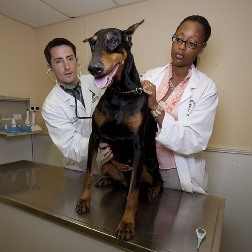How to Choose a Veterinary Assistant School in Alaska
 Fulfilling your lifelong aspiration of working with and caring for animals by enrolling in a veterinarian college in Alaska may at first feel like an overwhelming endeavor. After all, you need to locate and enroll in a school that will deliver the appropriate training so that you can be successful as a veterinary assistant, technician or technologist. But just how do you tackle assessing and comparing programs so that you can make the right choice? Many aspiring students start their due diligence process by searching for colleges that are close to their residences. After they have found some local schools, they determine which ones have the lowest tuition and focus on those. Although cost and location are significant concerns when evaluating vet tech schools, they are not the only critical ones when making your assessments. Qualifiers such as accreditation and internship programs should be considered as well. The point is that there are questions you ought to be asking the veterinary tech programs you are considering before you make an ultimate decision. We have furnished several within this article to help get you started, but before we review them we’ll go over the different duties of vet techs and assistants and the training options available.
Fulfilling your lifelong aspiration of working with and caring for animals by enrolling in a veterinarian college in Alaska may at first feel like an overwhelming endeavor. After all, you need to locate and enroll in a school that will deliver the appropriate training so that you can be successful as a veterinary assistant, technician or technologist. But just how do you tackle assessing and comparing programs so that you can make the right choice? Many aspiring students start their due diligence process by searching for colleges that are close to their residences. After they have found some local schools, they determine which ones have the lowest tuition and focus on those. Although cost and location are significant concerns when evaluating vet tech schools, they are not the only critical ones when making your assessments. Qualifiers such as accreditation and internship programs should be considered as well. The point is that there are questions you ought to be asking the veterinary tech programs you are considering before you make an ultimate decision. We have furnished several within this article to help get you started, but before we review them we’ll go over the different duties of vet techs and assistants and the training options available.
The Job of a Vet Assistant and Tech
 Among the first decisions that you will have to make is if you want to train as a veterinary assistant, technologist or technician. Part of your determination might be predicated on the amount of time and money that you have to commit to your education, but the principal determiner will undoubtedly be which specialization interests you the most. What vet techs and assistants share in common is that they each work under the immediate guidance of a licensed and practicing veterinarian. And while there are many jobs that they can carry out within the Alaska veterinary practice or hospital, they can’t prescribe drugs, diagnose conditions, or conduct surgeries. In those areas they can only furnish support to a licensed vet. There are technicians and technologists that work exclusive of the typical vet practice, for example for zoos, animal shelters or law enforcement. Let’s take a look at the responsibilities and education requirements for each specialization.
Among the first decisions that you will have to make is if you want to train as a veterinary assistant, technologist or technician. Part of your determination might be predicated on the amount of time and money that you have to commit to your education, but the principal determiner will undoubtedly be which specialization interests you the most. What vet techs and assistants share in common is that they each work under the immediate guidance of a licensed and practicing veterinarian. And while there are many jobs that they can carry out within the Alaska veterinary practice or hospital, they can’t prescribe drugs, diagnose conditions, or conduct surgeries. In those areas they can only furnish support to a licensed vet. There are technicians and technologists that work exclusive of the typical vet practice, for example for zoos, animal shelters or law enforcement. Let’s take a look at the responsibilities and education requirements for each specialization.
- Vet Assistants in most cases will have completed a structured training program, either as an apprentice or intern in a vet clinic or hospital, or by finishing a certificate program at a trade school or community college in Alaska. As the name implies, their job function is to assist the veterinarians and vet technicians in the execution of their duties. Generally they are not associated with more complicated tasks, for instance assisting with surgical procedures. Some of their normal responsibilities may include working at the front desk, preparing and cleaning exam rooms and equipment, or controlling animals during examinations.
- Vet Technicians get more extensive training in contrast to assistants and normally earn a two year Associate Degree, preferably from an American Veterinary Medical Association (AVMA) accredited program. They are in a sense the veterinary equivalent of medical nurses, since their general job duty is to assist vets with diagnosing and treating animal patients. Where they differ from veterinary assistants is that they are engaged in more involved activities, for instance assisting with surgeries or administering medicine. All states currently require vet technicians pass a credentialing exam for either registration, certification or licensing.
- Vet Technologists are comparable to vet technicians and essentially carry out the same work functions. They are mandated to attain a Bachelor’s Degree in veterinary technology, which generally takes 4 years to complete. So the main difference between a vet technologist and a technician is the technologist’s more advanced level of education. But with an advanced degree comes more job options, increased salaries and possible management positions. They are additionally mandated to pass a credentialing examination for either certification, registration or licensing.
Vet techs and technologists can specialize in areas such as anesthesia, internal medicine or urgent care. A number may obtain certification from the American Association for Laboratory Animal Science (AALAS) to work in labs or Alaska research facilities also.
Online Vet Training Programs
 An approach that may be a solution for those with a busy schedule or who are working full-time while attending vet school is to enroll in an online program. Because the classes are offered over the internet, students can attend on their own schedule wherever a computer is accessible. The curriculum is taught using multiple methods, including videos, slide shows and live streaming webinars. And since the majority of veterinary tech and technologist degrees require practical training, that portion can usually be carried out as an internship or work study program at a local Alaska veterinary clinic or hospital. Distance learning, as it is also called, can in some instances lower the cost of your education. Tuition and ancillary expenditures, for example for commuting and study materials, can be lower compared to more traditional classroom programs. Just make certain that the online school that you select is accredited, either by the AVMA or another nationally certified accrediting agency. With the online courses and the clinical training, everything is provided for a comprehensive education. So if you are dedicated enough to learn in this more independent fashion, an online veterinary tech or assistant school may be the perfect choice for you.
An approach that may be a solution for those with a busy schedule or who are working full-time while attending vet school is to enroll in an online program. Because the classes are offered over the internet, students can attend on their own schedule wherever a computer is accessible. The curriculum is taught using multiple methods, including videos, slide shows and live streaming webinars. And since the majority of veterinary tech and technologist degrees require practical training, that portion can usually be carried out as an internship or work study program at a local Alaska veterinary clinic or hospital. Distance learning, as it is also called, can in some instances lower the cost of your education. Tuition and ancillary expenditures, for example for commuting and study materials, can be lower compared to more traditional classroom programs. Just make certain that the online school that you select is accredited, either by the AVMA or another nationally certified accrediting agency. With the online courses and the clinical training, everything is provided for a comprehensive education. So if you are dedicated enough to learn in this more independent fashion, an online veterinary tech or assistant school may be the perfect choice for you.
What to Ask Vet Assistant and Tech Training Programs
 At this point you probably have selected which veterinary certificate or degree that you want to earn, and if you want to study online or attend a program on campus. Since there are an abundance of veterinarian community colleges, trade and vocational schools in Alaska and across the Country, you must ask some qualifying questions in order to narrow down your list of options. As we mentioned in our opening, many future students start by focusing on location and tuition expense. But we have already pointed out other essential qualifiers, for example internship programs and accreditation. And obviously you want to select a college that offers the degree and specialty that you are interested in. These and other qualifications are covered in the checklist of questions that you should ask the vet assistant and technician schools that you are looking at.
At this point you probably have selected which veterinary certificate or degree that you want to earn, and if you want to study online or attend a program on campus. Since there are an abundance of veterinarian community colleges, trade and vocational schools in Alaska and across the Country, you must ask some qualifying questions in order to narrow down your list of options. As we mentioned in our opening, many future students start by focusing on location and tuition expense. But we have already pointed out other essential qualifiers, for example internship programs and accreditation. And obviously you want to select a college that offers the degree and specialty that you are interested in. These and other qualifications are covered in the checklist of questions that you should ask the vet assistant and technician schools that you are looking at.
Is the Veterinary College Accredited? It’s important that you make sure that the veterinary assistant or tech college you enroll in is accredited by a regional or national accrediting agency. As earlier discussed, among the most highly respected is the American Veterinary Medical Association (AVMA). Vocational schools and colleges that are accredited by the AVMA have undergone a rigorous screening process that confirms you will get a superior education. Also, accreditation is important if you are applying for a student loan or financial aid, since many programs are not offered for non-accredited programs. Last, having a degree or certificate from an accredited college is in many cases a prerequisite for employment for many Alaska veterinarian practices and hospitals.
What is the College’s Reputation? The veterinary college or trade school and program you enroll in should have an excellent reputation within the veterinary field. You can initiate your due diligence by asking the schools you are interested in for references from the employers in their job placement network. Other suggestions include looking on online school ranking websites and checking with the school’s accrediting agencies as well. You can ask the Alaska school licensing department if there have been any grievances or violations concerning your targeted schools. As a final tip, get in touch with some veterinary clinics that you may wish to work for after you get your training. Find out what they think of your school choices. They may even recommend some colleges not on your list.
Are Internships Offered? The most effective way to get clinical hands on experience as a vet technician or assistant is to work in a medical environment. Find out if the colleges you are looking at have internship programs arranged with regional veterinarians, vet practices or hospitals. Most veterinary medicine programs mandate clinical training and a large number provide it through internships. Not only will the experience be invaluable regarding the clinical training, but an internship can also help establish associations in the local Alaska veterinary community and assist in the search for a job after graduation.
Is there a Job Placement Program? Finding a job after graduating from a veterinary assistant or tech school can be challenging without the assistance of a job placement program. First, ask what the graduation rates are for the colleges you are reviewing. A lower rate may signify that the teachers were ineffective at teaching the course of study or that some students were dissatisfied with the program and dropped out. Next, check that the colleges have a job assistance program and find out what their placement rates are. A high placement rate might mean that the Alaska program has an outstanding reputation within the veterinarian community and has a considerable network of contacts for student placements. A low rate could signify that the training is not highly regarded by employers or that the job placement program is a failure at placing students.
How Large are the Classes? If the classes are larger sized, you most likely will receive little or no individualized instruction from the teachers. Request from the Alaska programs you are researching what their classroom teacher to student ratios are. You might also want to sit in on a couple of classes (if practical) to observe the interaction between instructors and students. Get evaluations from students regarding the quality of instruction. Also, speak with the instructors and find out what their qualifications are as well as their methods of teaching.
Where is the College Located? Yes, we previously covered location, but there are a couple of more points to make on the topic. If you are planning to drive to your vet technician classes from work or home, you need to confirm that the commuting time is compatible with your schedule. For instance, driving during the weekend to check out the route won’t be the same as the commute during rush hour traffic, especially if the Alaska campus is located near or in a large city. In addition, if you do decide to attend a school in another state or even outside of your County of residence, there may be increased tuition costs especially for state and community colleges. Of course taking online classes may be an alternative that will give you more flexibility and minimize the necessity for travel.
Do the Classes Fit Your Schedule? And last, it’s imperative that you determine if the Alaska veterinary programs you are looking at offer class times flexible enough to fit your schedule. For example, a number of students continue to work full time and can only go to classes on the weekends or at night. Some might only be able to attend class in the morning or later in the afternoon. Confirm that the class times you need are offered before enrolling. In addition, find out if you can make up classes that you might miss because of work, sickness or family responsibilities. You might find that an online program is the best way to fit your vet training into your hectic life.
Choose the Ideal Veterinary Technician Program in Alaska
Selecting the right vet technician school is a critical first step to starting a fulfilling career providing treatment and care for pets and livestock. Students thinking about vet tech or assistant programs must make their decision based on several key issues. Vet assistants, techs and technologists are employed in veterinary clinics and hospitals and animal shelters. They usually handle administrative duties and assist the veterinarian with the animals when needed. As we have covered, it’s essential that you choose a veterinary medicine program that is both accredited and has an outstanding reputation within the field. This applies to vet tech online schools as well. By asking the questions included in our checklist for assessing schools, you will be able to narrow down your choices so that you can make your final choice. And by selecting the ideal school, you can reach your goal of becoming a vet assistant, tech or technologist.
